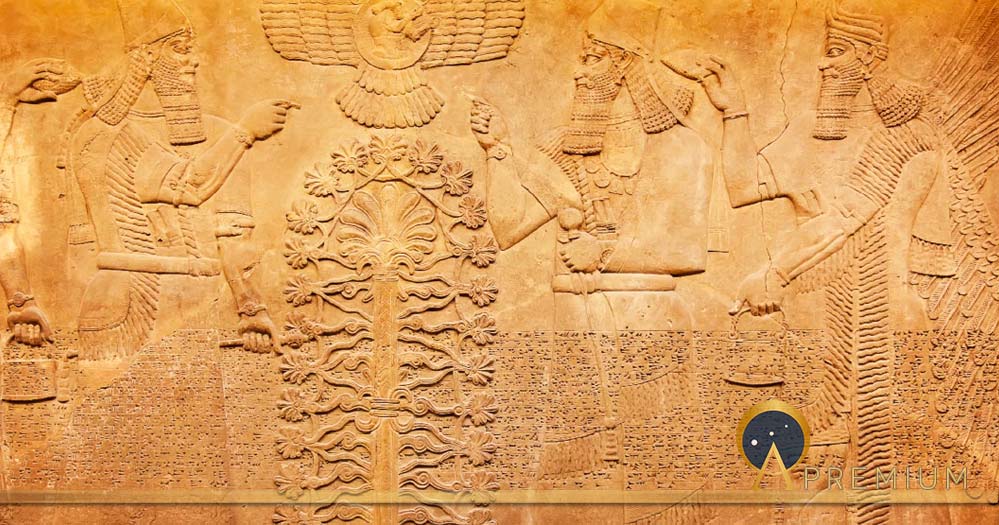
Eden Revisited: The Sumerian Version
- By jim willis
- 0
Sumer, in Mesopotamia, was called ‘the land of civilized kings’. It reached its peak around 6,500 years ago when it had the distinction of being a very advanced civilization with a sophisticated written language, magnificent architecture for the time, complex mathematics, and amazing astronomy. Hundreds of gods comprised its religious system. Sumerians believed that although humans and the gods once shared the earth together, they didn't share a co-equal existence. Humans, they believed, were designed for the express purpose of serving the gods. Their chief god, Anu, commissioned his son, Enki (Ea), and his daughter Ninki (Enki's half-sister) to create humans by sacrificing a god, mixing his body and blood with clay, and forming the first human being made in the likeness of the gods.
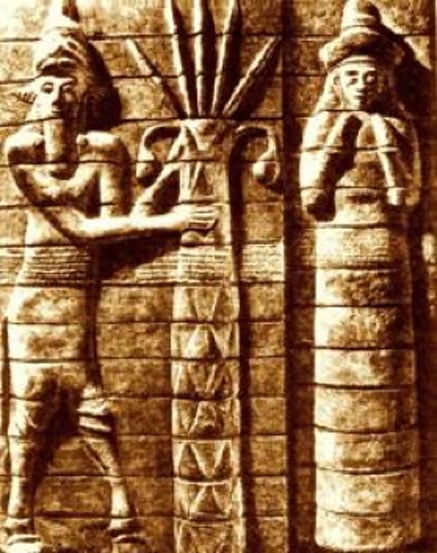
Enlil and Ninlil (Public Domain)
The Creation of Man: Adapa
According to Sumerian mythology, human-like gods called Anunna had initially come to mine resources that were needed on their home planet. Now, with the creation of a human labor force, their duties were changed. They ruled over what was, for all practical purposes, a human slave race. Their base of operations was Mesopotamia, the land between the Tigris and Euphrates river. In the Epic of Gilgamesh, the world's first epic poem, it was called Eden.
At first, according to the texts, humans were unable to reproduce on their own. This proved inconvenient. So, Enki and Ninki found a way to modify the new species. The result was a man called Adapa, a fully functional and independent human being. Enki had given Adapa great wisdom and the ability to understand the concept of eternal life. But Adapa's curse was that he could never attain that which he was able to conceive.

Detail of The Adda Seal. Goddess Inanna, god Utu, god Enki and chief minister Usimu. (Public Domain)
Were it not for the Amarna texts, discovered all the way over in Egypt in the archives of the Egyptian king Amenophis, we might never know about Adapa. But in 1912 his story was verified and confirmed by a unique discovery in the Library of Ashurbanipal. Five partial fragments, since translated, were revealed that told part of the story, called Adapa and the South Wind.
According to the story, Adapa had risen to the position of priest or sage. One day, while fishing in the Persian Gulf, the sea became rough and his boat capsized. Adapa became angry and: "broke the wings of the south wind." He prevented it from blowing for seven days and nights. This, of course, caught the attention of the god Anu, who wanted to punish Adapa for the sin of hubris. But Enki came to Adapa's aid. He instructed him to journey to the abode of the goddess Tammuz, who, along with Gishzida, stood guard at the gates of heaven. While there, he was told not to eat or drink anything because heavenly food would kill him.
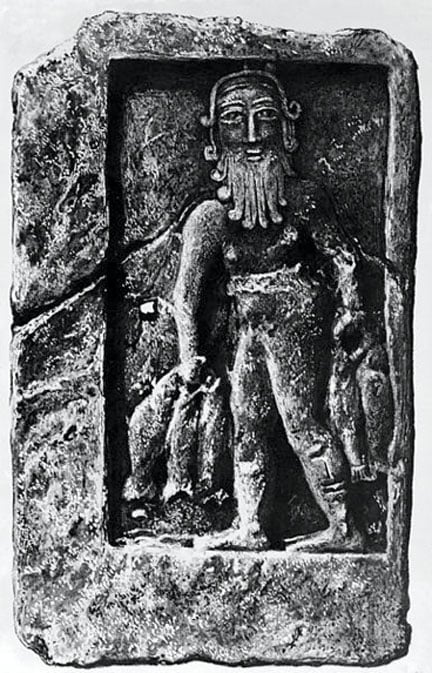
Adapa Sumerian deity of healing (Wellcome Images / CC BY-SA 4.0)
Adapa put on traditional sackcloth and ashes, the garb of mourning, and appeared before Tammuz and Gishzida, claiming he was in mourning because the two gods had disappeared from his land. Ever hospitable, they offered Adapa food and drink. Forewarned, he refused. Only later did he come to understand that he had made a mistake. When he was brought before Anu, Anu asked why he hadn't eaten the food that had been placed before him. He said it was because Enki had told him not to eat: "the bread and water of life."
- The Sumerian Seven: The Top-Ranking Gods in the Sumerian Pantheon
- Reading the So-Called Sumerian Seals Relating to Gods from Outer Space
- The origins of human beings according to ancient Sumerian texts
At this, Anu laughed: "What ill has Adapa brought on mankind?" If Adapa had partaken of the food, he would have obtained immortality. As it is, humankind, the creation of Enki, would henceforth suffer disease and death.
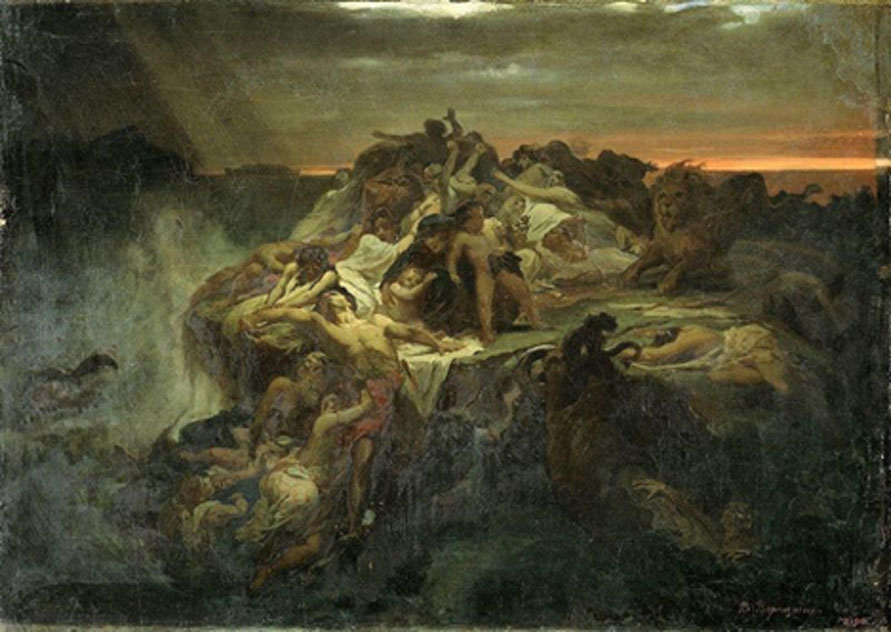
The Flood by Vasily Petrovich Vereshchagin (1869) (Public Domain)
The Deluge
Compare this story to the biblical account. In Genesis, God forbid the first man from eating of the Tree of Immortality. In the Sumerian version, it was Enki. This is about to become an important distinction.
Adapa was sent back down to earth. Now the plot thickens. Enki's brother, Enlil, hadn't been told about Enki's work. He had wanted only an obedient slave race, and now Enki was tinkering with things like wisdom and eternal life. Enlil and Enki fought, and the battle continues to this day.
Enlil advised the gods that he was going to destroy the newly created human race with a great flood. Afterwards, he reasoned, they could start over from scratch. But Enki overheard the plans and contacted a righteous man named Utnapishtim.
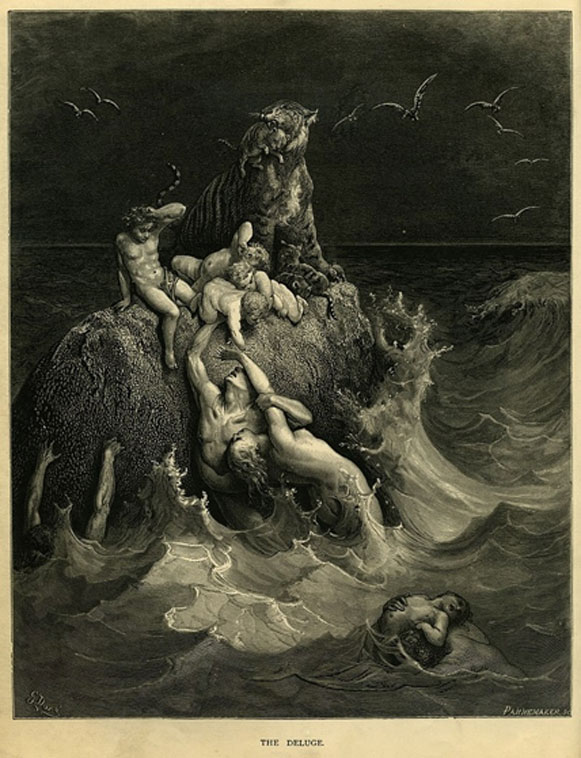
The Deluge, frontispiece to Gustave Doré's illustrated edition of the Bible. Based on the story of Noah's Ark, this engraving shows humans and a tiger doomed by the flood futilely attempting to save their children and cubs.(1866) (Public Domain)
Ancient Sources Predating the Bible
It's important to remember that the Sumerian authors didn't believe they were the earliest human civilization. They claimed to have received all this from an earlier civilization that had, by their time, become extinct. Who comprised this civilization, and where they came from, is a mystery.
Added to the dilemma is the fact that when we read a text such as the Bible, we are reading the edited work of scholars who lived centuries ago. They made choices, compiling one work and condensing another, so it seems as if we are reading a seamless book written by one author. No one ever did that with ancient Sumerian texts. We read a little of this and a little of that, from here and there, and the story doesn't seem as uniform as the familiar Hebrew text. On top of that, some of the old texts are written in Sumerian hieroglyphs, some in Babylonian cuneiform, and others in ancient Egyptian. A modern editor has a lot to choose from, and can snip a little from one text or another, confidant that most of us, who don't read any of the ancient languages, will be none the wiser. But a comparison of Sumerian and Biblical texts, even in translation, is revealing.
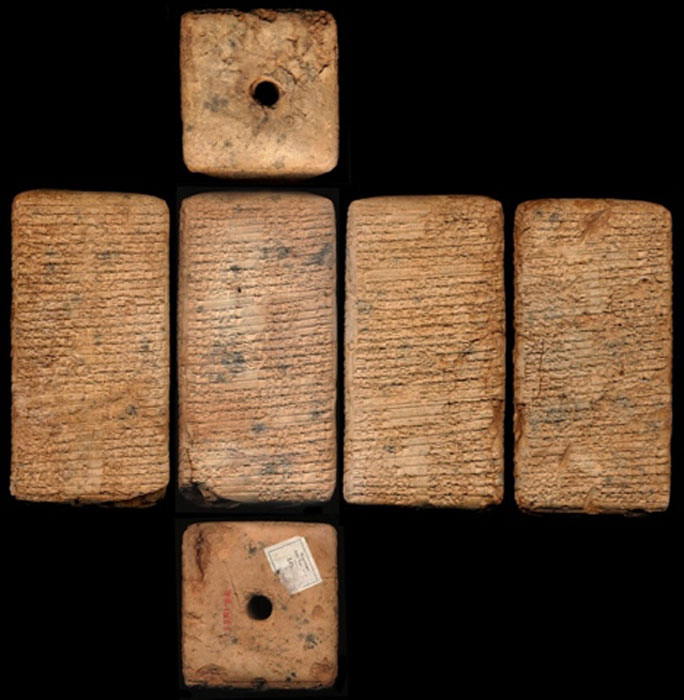
Sumerian Temple Hymn (Walters Art Museum / Public Domain)
One of the most important Sumerian texts is called Enki and the World Order. In this myth, Enki decided that the world needed to be managed by the gods or it would descend into chaos. He appointed various overseers to supervise such activities as managing the use of water and crops, building cities, herding domestic animals, overseeing the heavens, and managing the activities of women.
Both the Genesis Eden Story and the Sumerian texts address similar issues and help us understand what was going on in the minds of the old ones at the time of the birth of our civilization. They can be read as metaphors for historical precedents such as the agricultural revolution and city building. They are an attempt to explain why things are the way they are in the world. They point back to an earlier civilization, now lost to history. They reveal that our ancestors thought long and hard about philosophy and psychology. They point to what was even back then considered a lost golden age—paradise. They try to plumb the depths of human behavior and ask questions about the nature of good and evil.
In that sense, things haven't changed a great deal in the last 5,000 years. But there is another way to read these two stories. From a religious perspective, they are very different.
Is Eden Paradise?
Anton Parks is a French scholar who has devoted years to the Sumerian texts, even going so far as to translate them himself. He points out that the Bible portrays our ancient ancestors being very happy in Paradise. In the Sumerian texts, they are living in a concentration camp. In his translation God doesn't plant a garden for humankind in which he: "walks in the cool of the evening," as in Genesis. His version says the gods: "came in strength from beyond time. They were carried, one day, by the rebellion of the universe." His gods, the Anunna, were very real entities from beyond, who represented a patriarchal and a matriarchal regime. Enlil, the so-called ‘evil’ god who wanted to enslave the human race, was quite different from Enki, who befriended them.
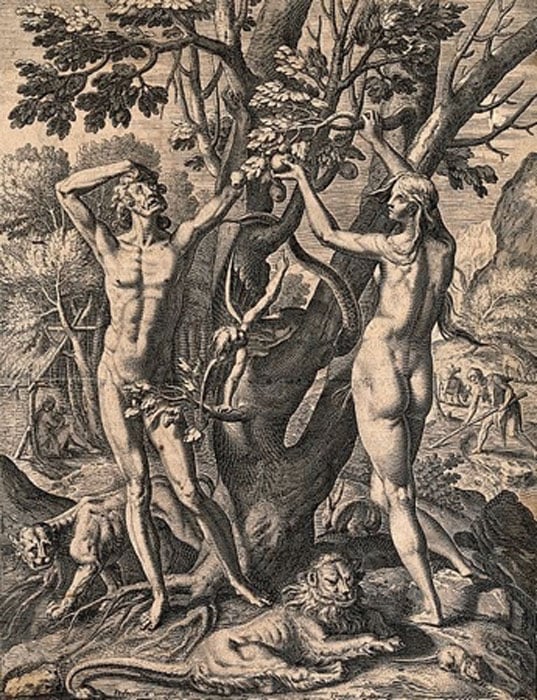
A woman-serpent bends around the Tree of Knowledge as Adam and Eve reach into the branches. Line engraving by T. de Bry after J. van Winghe. (Wellcome Images / CC BY-SA 4.0)
The feminine presence, represented by Ninki, is often portrayed as a reptilian figure. Could she have been the inspiration for the serpent in the Eden of Genesis? If that is the case, then the serpent wasn't evil at all. She was trying to free humankind by offering them the gift of the knowledge of good and evil. She then wanted them to eat of the Tree of Life and: "be like gods." It was a good thing she was doing, not a bad one.
But Enlil won the day. Although he failed to keep them from eating the fruit of the Tree of Knowledge, he cast humans out of the garden before they ate from the Tree of Life. And since history is both interpreted and written by the winners, Enlil's story was later told in Genesis, not Enki's. That explains why the Genesis account emphasizes the fact that sword-wielding cherubim, or ‘Shining Ones’, were placed at the entrance to Eden in order to ensure that humans never attain the godhead, or eternal life. It has been said that the smartest thing the devil ever did was to convince humans that he didn't exist. This reading of the Sumerian myth goes one step further. It says that the smartest thing the devil ever did was to convince humans that he was God.
Jehovah the Evil God Enlil
According to Anton Parks, YHVH of the Bible, translated ‘The Lord’, is not the Creator. The creator is Enlil, the enslaver of humankind, henceforth known as the Demiurge. He is head of the Patriarchal system that wants to suppress freedom, especially the freedom of women. He doesn't want equality. He wants subservient slaves. He doesn't want creative, right-brained, intuitive thinkers. He wants left-brained, obedient servants who are forced to toil every day.
This reading of the story says that humans were upright-walking animals who were modified through DNA manipulation to fill the role of worker bees. The word Adam in Sumerian, according to Parks, means ‘animal’. Eden consists of the words E, meaning ‘home’ and den, which means ‘life’. Satan, in Sumerian, means ‘The Administrator’.
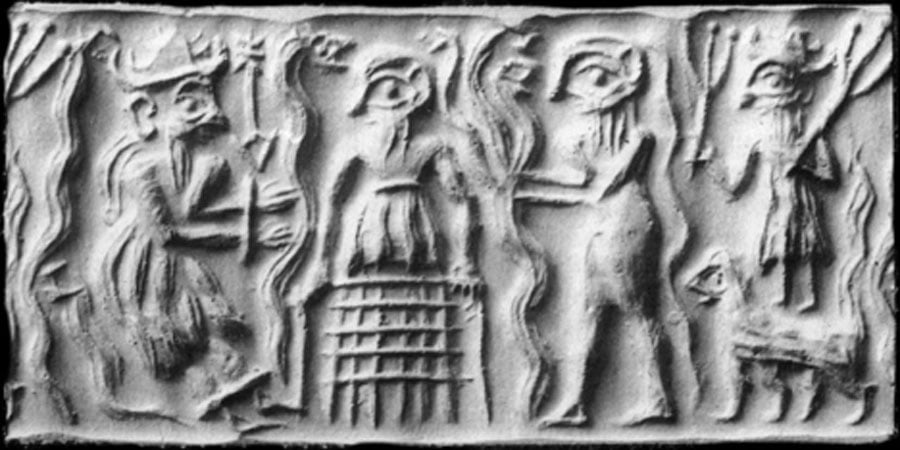
Ancient Sumerian cylinder seal impression showing the god Dumuzid being tortured in the Underworld by galla demons (Public Domain)
Enki managed to grant wisdom to humans when he, through Ninki, the ‘serpent’ of Eden, gave them the ability to discern between good and evil. That caught Enlil by surprise. The best he could do was to drive them out of Eden and forbid their return. To put it bluntly, according to this reading of the story, the God whom monotheists have been worshipping for the last 5,000 years is not Jehovah, the creator God. He is Enlil, the patriarchal Demiurge—Satan himself. This explains the God of the Old Testament who sent the flood to destroy humankind, who commanded the Israelites to kill innocent Canaanite women and children, who was the justification for the Crusades and the Inquisition, who seems so incredibly bloodthirsty. It explains why the author of John in the New Testament could declare that: "we know we are of God and the whole world is in the hands of the evil one" (1 John 5:19). He recognized that humans have been fighting the good fight, trying to get back to Eden.
According to this interpretation, we are caught in a divine battle of competing spiritual forces. We still need to: "earn our daily bread by the sweat of our brow." It's just that we have turned our curse into a search for meaning. We want to get back to Paradise.
![Gustave Doré, illustration to Paradise Lost"... he [Satan] held on /His midnight search, where soonest he might finde /The Serpent: him fast sleeping soon he found ..."(Public Domain)](https://members.ancient-origins.net/sites/default/files/Gustave-Dore_0.jpg)
Gustave Doré, illustration to Paradise Lost"... he [Satan] held on /His midnight search, where soonest he might finde /The Serpent: him fast sleeping soon he found ..."(Public Domain)
Sophia, Wisdom the Word of God is Feminine
There are indications that the Gnostic texts, discovered in Nag Hammadi, Egypt, in 1945, sympathized with this version of the story. The Gnostics were an early Christian sect that was declared heretical by the Roman establishment. The church burned their scriptures and made sure none of them, except for perhaps, the Gospel of John, made it into the New Testament. But with the discovery of books that had been hidden away and kept from destruction, we now know that to the Gnostics, wisdom, or Sophia, represented a feminine energy that refused to be kept buried. She was the Logos, or Word of God.
The Gnostics believed there was a bigger game being played out, by forces outside of planet Earth. The universe is bigger than we realize, they declared. As a matter of fact, the universe is simply one cell in the immense body (Multiverse) that is God. Here on earth the battle between good and evil, between the feminine and the masculine, between Enki and Enlil, is raging. But good will eventually triumph.
This religious system of belief says we have an ‘angel’ on one shoulder and a ‘devil’ on the other. Their names are Enki and Enlil. The earth may be the domain of the Demiurge, but that domain itself is called ‘Mother Earth’, the world of Sophia, the goddess of wisdom, the divine spark that Enlil, the devil, strives to put out. The Demiurge may dominate our day to day reality, but Eden still awaits if we can only persevere. And we are not alone in the battle.
This is a completely different reading than the biblical account many of us grew up with, and whether we read it allegorically or historically, it causes us to pause and think about what we have been taught in our impressionistic youth—to contemplate the idea that we are involved in something a lot bigger than we thought.
This article is an edited excerpt from the Jim Willis’ new book, Lost Civilizations: The Secret Histories and Suppressed Technologies of the Ancients, published by Visible Ink Press available from October 2019.
Jim Willis is author of several books on religion and spirituality, he has been an ordained minister for over forty years while working part-time as a carpenter, the host of his own drive-time radio show, an arts council director and adjunct college professor in the fields of World Religions and Instrumental Music. He is author of Supernatural Gods: Spiritual Mysteries, Psychic Experiences, and Scientific Truths and Ancient Gods: Lost Histories, Hidden Truths, and the Conspiracy of Silence
Top Image: Sumerian Artifact with the Tree of Life. (swisshippo / Adobe Stock)
By Jim Willis
References
Ashton, J. and Whyte, T. 2001. The Quest for Paradise: Visions of Heaven and Eternity in the World's Myths and Religions. New York: Harper Collins
Parks, A. 2013. Eden: The Truth About our Origins. Panhana Books.
Sitchin, J. 2015. The Anunnaki Chronicles: A Zecharia Sitchin Reader. Rochester, VT: Bear & Co.
Sitchin, Z. 2002. The Lost Book of Enki. Rochester, VT: Bear & Co.
Willis, J. 2016. Ancient Gods: Lost Histories, Hidden Truths and the Conspiracy of Silence. Detroit, MI: Visible Ink Press.




